- Submissions

Full Text
Aspects in Mining & Mineral Science
Study of Laws of Electromagnetic Fluxes During Induction Surfacing Powder Layer
Sosnovsky Igor A1*, Kurilyonok Artem A1 and Kuznechik Oleg O2
1Joint Institute of Mechanical Engineering of the National Academy of Sciences of Belarus, Belarus
2Powder Metallurgy Institute, Belarus
*Corresponding author: Sosnovsky Igor A, Joint Institute of Mechanical Engineering of the National Academy of Sciences of Belarus, Belarus
Submission: April 27, 2022;Published: June 06, 2022

ISSN 2578-0255Volume9 Issue2
Abstract
The article shows that in order to optimize the parameters of the magnetic flux, it is proposed to use the functional of the energy of the call, which contains, in addition to the force characteristics of the electromagnetic field strength, and the magnetic vector potential. It is shown that the powder layer of induction surfacing belongs to a system with concentrated parameters, in which the skin-effect is due to the size of the zone. In accordance with this study, schemes and a system of equations are described that determine the nature of electromagnetic flow control during induction surfacing of the powder layer and the possibility of optimizing the technological parameters of the process.
Keywords: Induction surfacing; Powder layer; Optimizing the technological parameters; Electromagnetic field; Pointing vector
Introduction
Induction surfacing of powder materials is widely used in machinery for applying functional coatings on the internal surfaces of steel parts running in friction [1-3]. The coating process involves compacting, heating and isothermal holding [4]. The powder layers molding may be, for example, using centrifugal forces, and their heating to the melting point - due to heat transfer from the heated surface layers by induction currents [5] in substrate material which in many cases is steel. The source of the appearance of eddy currents are the electromagnetic field of the unsteady inductor current [6,7]. Currently, the link between emerging of the induction heating by the electromagnetic field and the electromagnetic energy flow has not been studied. The aim of our investigation is to study the laws of flow control electromagnetic induction during surfacing of powder layer:
a.
analysis of Maxwell’s equations describing the electromagnetic field and the electromagnetic power flow in the inductor and the steel base and the powder bed;
b.
formulation of an equations system defining the laws of electromagnetic control energy flows in the induction surfacing powder layer and optimization of process parameters.
The Electromagnetic Field of the Inductor and the Electromagnetic Energy Flow During the Induction Surfacing
Based on the results of [5,6] and [7] the generation of the electromagnetic field is determined by the current pulse parameters of the inductor: voltage (U), current (I), power (P), the angular frequency (ω) and the duration (t). Conversion of the electromagnetic field between the inductor and the steel surface with a powder layer (Figure 1) into an electromagnetic energy flux is determined by the electromagnetic field vectors (E and H) of and the electromagnetic induction vectors (D and B) in the material. In classical electrodynamics the electromagnetic field in this medium is determined by Maxwell’s equations. These equations in combination with the idea of the continuity lines of force LSB0, LSD0, (Figure 1) and the law of conservation of energy (W) allow to link the bulk density of the transferred electromagnetic energy flow (w) with the power characteristics of the electromagnetic field:
Figure 1: The circuit of the magnetic flux in the gap of the inductor. LSB0, LSD0 – lines of force caused by electromagnetic field; В0, D0, P0 – electromagnetic induction vectors and the Pointing vector; 1 – inductor coils, 2 – steel substrate, 3 – the powder layer.
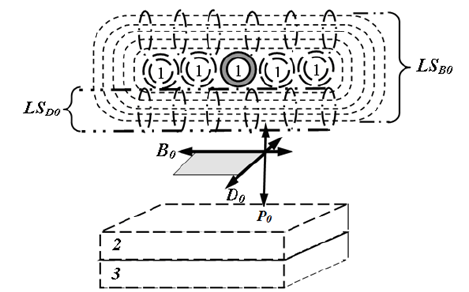
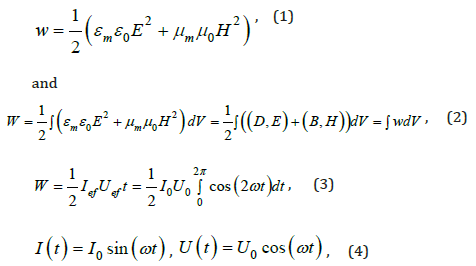
where Ief, Uef – effective values of current and voltage of the inductor; I0, U0 – the amplitude of the current and voltage of the inductor. The law of electromagnetic energy conservation is determined by the equation:

The total flux of electromagnetic energy through the surface S is Φ:

where Pn – Pointing vector projection on the normal to the surface S. The technological systems for the induction surfacing of powder layers on steel substrate typically use an alternating electrical current with the cyclic frequency of 1-100kHz. This simplification makes it possible to consider the conversion of electromagnetic energy flow associated with the transition from the inductor to the steel substrate with a powder layer (Figure 2), only as replacement electromagnetic properties of the medium. When the electromagnetic energy flux spreads in a conductive medium (in a steel substrate and a powder layer) a portion of the electromagnetic energy will been absorbed as the heat (Figure 2). Considering expressions (5) and (6) the distribution of flow of electromagnetic energy in the steel substrate and in the powder layer is determined by the following expressions:
Figure 2: The transformation scheme of the electromagnetic energy flow during the induction surfacing. 1 – inductor, 2 – steel substrate, 3 – the powder layer, Φ1, Φ2, Φ3 – electromagnetic energy fluxes, P1, P2, P3, – Pointing vectors

Figure 3: The scheme of induction surfacing of powder layer. 0 – inductor, 1 – clearance, 2 – steel substrate, 3 – the powder layer.
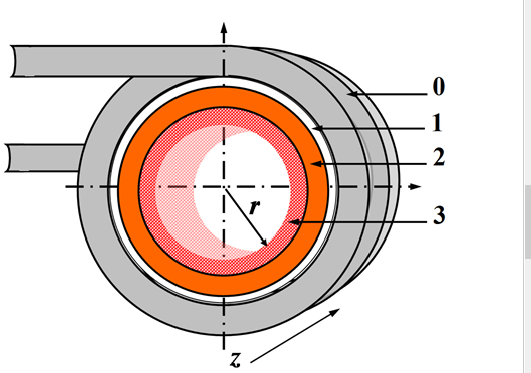
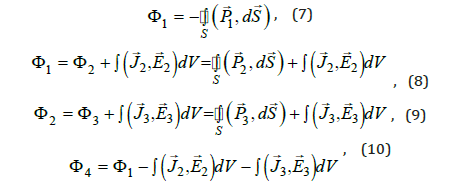
where P1, P2, P3, P4 – Pointing vectors in the inductor, in a steel substrate, in the powder bed and after powder layer; J2, J3 – current density in the steel substrate and the powder layer; Е2, Е3 – the electric field vector in the steel substrate and in the powder layer. The scheme of power conversion circuit inductor current in an electromagnetic field and electromagnetic power flux, and then in a power density heat sources in the steel substrate and in the powder, bed is shown in Figure 3. The electric field E and magnetic field H in steel substrate and in powder layer are determined by the equations:
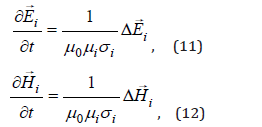
where 7 μ0 4 π 10= ⋅ ⋅ − H/m, μi – the relative magnetic permeability, σi – conductivity, i=2,3 – steel substrate, the powder layer. The vector current density Ji is determined by the vector of the electric field Еi. The electric field Еi, magnetic field Hi and current density Ji are continuous at the boundaries. The temperature in the steel substrate T2 and in the powder layer T3 is determined from the equations:

where i=2,3; сi, γi - specific values of the heat capacity and density of the material; λi - the thermal conductivity of the material. The joint solution of the equations (1-13) allows to optimize the parameters of induction surfacing of powder materials.
Conclusion
A system of equations describing the patterns of electromagnetic energy flows at the induction surfacing powder layers has been formulated. The system of equations includes equations which determine the electromagnetic field distribution in the powder bed, the steel substrate and heat balance equations in a powder layer and the steel substrate. Solution of the system allows you to optimize the induction surfacing of powder coating layer.
References
- Khudoley AL (1997) Development of technology induction sintering using stratified rotational molding. INDMASH: Minsk, Russia, p. 21.
- Dorozhkin NN, Kashitsin LP (Eds.), (1993) Centrifugal coating of powder coatings at variable force impacts. Navuka i tehnika: Minsk, Russia.
- Antsifirov VA (1987) Powder metallurgy and sprayed coatings. Metallurgy, Moscow, Russia.
- Kiparisov SS, Libenzon GA (1980) Powder metallurgy. Metallurgiya, Moscow, Russia.
- Maslikov PA (2014) Study the conditions for obtaining liquid phase titanium alloys inside cylindrical bodies in induction heating. LETI: St Petersburg, Russia, p. 23.
- Zaikina NV (2010) Modelling and optimization of process control induction heating aluminum billets rotating in a magnetic field of direct current. Samara State Technical University, Russia, p. 24.
- Achakov KA (2012) Research and development of induction heating of transformer oil in the recovery systems. Vestnik Samara Technical University Series: Engineering, Samara State Technical University, Russia, pp. 210-224.
© 2022 Sosnovsky Igor A*. This is an open access article distributed under the terms of the Creative Commons Attribution License , which permits unrestricted use, distribution, and build upon your work non-commercially.
 a Creative Commons Attribution 4.0 International License. Based on a work at www.crimsonpublishers.com.
Best viewed in
a Creative Commons Attribution 4.0 International License. Based on a work at www.crimsonpublishers.com.
Best viewed in 







.jpg)






























 Editorial Board Registrations
Editorial Board Registrations Submit your Article
Submit your Article Refer a Friend
Refer a Friend Advertise With Us
Advertise With Us
.jpg)






.jpg)














.bmp)
.jpg)
.png)
.jpg)










.jpg)






.png)

.png)



.png)






